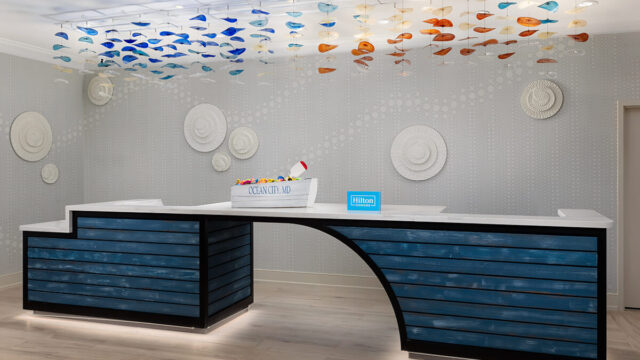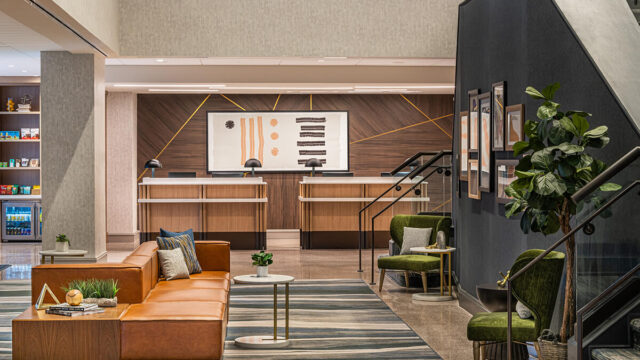Designing to meet guests’ post-COVID expectations is nothing new. Designing to meet wellness and sustainability expectations is also no stranger to hotel designers. But how are these expectations impacting the travel industry? What’s on the horizon and how should firms work to ensure design stands the test of time? We asked these very questions to design experts. Here’s what they had to say:
David Shove-Brown (pictured above), partner/cofounder, //3877
We’ve been talking about wellness-inspired design in hospitality for years. What’s changed in recent months?
Recently, many have started looking at wellness in hospitality as a holistic concept. Rather than designing a gym in the basement with a treadmill and a few weights, it’s become a more centralized, personalized concept. Hospitality is beginning to embrace the everyday importance of wellness, finding creative ways to incorporate it into the overall concept of the experience that merges into the ethos of the brand itself.
For hotels that haven’t incorporated much wellness design in the past but now want to, where should they start?
Own what you’re good at: if your hotel is small and can’t allocate the appropriate space for a fitness center, then don’t do it. Utilize local resources and get creative, such as partnering with the gym down the road to invite guests into a space that can cater to their needs, whether their definition of wellness is lifting weights, doing yoga or running. Recently, I stayed at a hotel that curated a customizable run around the town, allowing me to select the length, intensity and pre-mapped route. This presents a creative, immersive way for guests to explore the surrounding community while promoting physical and mental wellness, adding a unique, memorable layer to their experience. As we continue to explore the future of wellness tourism, hoteliers can find ways to incorporate wellness into a well-rounded, human-centric concept for guests.
Are you seeing any wellness design trends? What’s a ‘fad’ and what’s here to stay?
I’ve recently noticed an increase in offerings for in-room fitness and wellness, and while it is an interesting concept, it has to be executed correctly. It’s a great way to cater to people who don’t necessarily want to be in a gym (especially during COVID-19), but must be supplemented by other ways to engage guests, such as the running service I mentioned; keep equipment at the front desk for guests to request, add wellness to the concierge service, give wellness a real human touch that lets guests know its a priority.
Keeping with that, how do you keep wellness design fresh yet timeless?
The definition of wellness is different for everyone, but one thing that tends to be a consistent desire is a fresh, welcoming atmosphere. Incorporating natural light and biophilia into wellness design are great ways to provide an energizing, serene environment for guests. We’re also seeing more and more of our clients requesting fitness spaces that have a direct connection to the outdoors, whether it be large doors that open up to bring fresh air into the space or fitness centers that have a direct connection to outdoor amenities, such as pools.
What challenges are hotel designers currently facing when it comes to wellness design?
Some hotels are struggling to meet the diverse desires of guests as it relates to wellness. Each person has different needs, abilities and preferences when it comes to well-being, and the classic basement gym doesn’t cut it anymore. As more of the industry evolves to incorporate creative ways to cater to individual wellness expectations, hotels will have to adapt to a new standard to compete.
How should they overcome those challenges?
The concept of individualized wellness doesn’t have to exist exclusively in permanent installations; I’ve been to hotels where they offer live plants for guests to care for throughout their stay—and who doesn’t love a pet plant? Seemingly simple touches like that demonstrate a commitment to holistic guest wellness, curating an experience that fits each visitor’s unique definition of physical and mental wellness.
What about some opportunities?
It’s important to utilize technology as a tool and not a cop-out—you can’t throw a few Peloton bikes in the gym and call it a day. There are great opportunities to diversify wellness offerings to guests through apps—this digital form of wellness provides a world of opportunity that fits into your pocket. In the future, I’d like to see hotels partnering with these programs, such as Mirror, to expand their customizable (and in-room) offerings.
Is there anything else readers should know about wellness design in hospitality?
Wellness in hospitality has extended well beyond amenities; it now speaks to the ethos of a hotel, providing a great opportunity for brands to form genuine, long-standing relationships with guests.
Samuele Sordi, chief architect, Pininfarina of America

We’ve been talking about wellness-inspired design in hospitality for years. What’s changed in recent months?
Recently, we’ve observed an increase in environmental awareness that correlates with a desire to be outdoors. This shift is likely fueled by the remnants of the pandemic’s months of isolation and limited travel, as well as a greater general awareness of the environment.
For hotels that haven’t incorporated much wellness design in the past but now want to, where should they start?
The best way to approach elevated wellness design is from a user-centric perspective; think of the experience you want to give each guest, the way you want them to feel. Our team understands that each client, project and site is completely unique, therefore requiring a tailored, individualized approach to each design. We tackle these opportunities and challenges one by one, finding ways to optimize individual wellness, community and sustainable solutions for the benefit of the client and the end-users alike.
Are you seeing any wellness design trends? What’s a ‘fad’ and what’s here to stay?
The presence of nature and biophilic elements in interiors has been present in the typological urban fabric forever—such as Japanese gardens and Italian courtyards. In recent years, these elements have become increasingly more present, with people craving greenery and plants in their environments—further highlighting the importance of this relationship between interiors and the natural environment. We are observing a return to this concept in both the selection of materials and in the technique in which they are being used, from sourcing local materials—which can be long lasting and sustainable (such as reducing transportation-related emissions)—to techniques of handling said materials.
It’s innate to utilize the built environment as protection and comfort; we place buildings in a certain orientation to take advantage of natural elements like sunlight, we adjust the thickness of walls based on the climate, etc. We are inching closer to our primitive and essential needs, rediscovering traditions and attitudes that have always and will always be there.
What challenges are hotel designers currently facing when it comes to wellness design?
Wellness design is not just about the aesthetic: a selection of colors, materials and finishes don’t equate to a well-rounded consumer experience. A genuine wellness-focused project includes services and amenities that are aligned with a healthy, well-being lifestyle. For example, buildings can find unique ways to incorporate and stimulate physical activity in unconventional ways—think of a running track on the rooftop of a hotel, or having open and outdoor spaces that facilitate guests’ connection with nature.
How should they overcome those challenges?
As an example, a project in an urban environment may be able to utilize an area or space detached from the hotel, allowing guests to experience the hotel and surrounding area in a different way, creating a diffused experience. In this sense, a stay isn’t reduced down to one stagnant location, but the experience is spread throughout, creating an interconnection between hospitality and the surrounding neighborhood or the city. This communication of physical places stimulates the interconnection between places and people as well as tourists and locals, enhancing the overall social experience.
What about some opportunities?
Urban regeneration can be fueled by the increasingly common abandoned real estate that can then be reused and revamped into new, fresh built environments—this concept can also play into the idea of the interconnected hotel and surrounding area concept. Utilizing this opportunity can regenerate portions of abandoned buildings, unused public spaces and gardens to enhance the quality of the hospitality experience in existing spaces.
Is there anything else readers should know about wellness design in hospitality?
A large portion of wellness has to do with how we eat and food sustainability, so I think there is a lot of potential to incorporate these ideas into the future of hospitality design.




